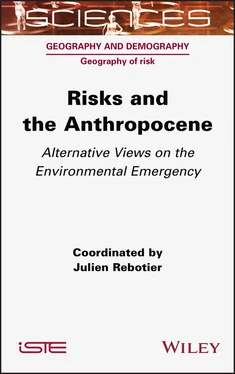This is the meaning of the status of the social in the environment. Natural, ecological, physical conditions or planetary limits are not, for the social sciences, the cardinal terms of the environmental problem. Rather, through the classic but robustly updated idea of the co-production of nature (Braun and Castree 1998; Ekers and Loftus 2012), it is social and political conditions that are central to ways of regulating a shared, safer and more sustainable world. The environmental problem does not surround the social world. It is a product of it, the result of social relations and interactions between societies and their environments (Ribot 2014).
Seen from the South, what difference does it make to interrogate risks in the Anthropocene? What new things does the Anthropocene introduce for those whose world has already collapsed or whose inequalities are already difficult to bear (Bouisset et al. 2018)? It has been known (read and written about) for decades that development (a form of social relations and relationships with the environment) constitutes the matrix of the greatest social challenges – with multiple environmental variations. What remains is to put relational intelligence at the service of one of the fundamental mandates of risk studies: to practically and sustainably reduce the risks of disaster by pointing out and acting on the multiple causes and on the differentiated consequences of harmful events.
I.4. Insights on risks in the Anthropocene era
Based on the Anthropocene moment, nine chapters have been proposed for the study and management of risks by providing elements of response in three parts, posed as three questions. The first part, “Toward new risks?”, discusses types of risk (coastal risks, fires, urban climate) that have emerged or been renewed by the Anthropocene context. The second part, “Recompositions for the study and management of risks?”, evaluates what the Anthropocene moment is doing to the classic themes of risk studies: the risk society, the management of disasters or prevention policies that are always the mark of attributes of power. The third part, “What consequences for a changing modernity?”, takes a step back from the Anthropocene moment and draws the (at least potential) contours of future worlds. It includes an ethnography of flood prediction systems in Europe, an analysis of the shift to a world of uncertainty and a practical philosophical examination of an old challenge for action: the necessary action in a radically uncertain world.
Each contribution is positioned in its own way around common problematic orientations, recalled by this general introduction. It is possible to navigate between the autonomous chapters because of explicit cross-references throughout the text and to the general index of the book.
These reflections all feed questioning in the social sciences. They bring together authors who, for the most part, are involved in risk studies. At the heart of the book, highlighted by reflections on the Anthropocene, we find risks as research objects, as supports and markers of the social and as modalities and manifestations of interactions between societies and environments. The general perspective assumes a form of déjà vu by being part of several decades of social science research on risks. The notion of the Anthropocene, despite its success, should neither be used to neglect the critical knowledge already produced on risks, their study and their management, nor to elude the obstacles already identified. The introduction of the notion of the Anthropocene into the debate on risk thus serves as a revelation of certain salient points, or as a moment of reference for drawing up forward-looking assessments.
Anders, G. (1995). De la bombe et de notre aveuglement face à l’apocalypse . Titanic, Paris.
Beck, U. (1992). Risk Society: Towards a New Modernity . Sage Publishing, London and New York.
Berdoulay, V. (2008). La formation de l’école française de géographie (1870–1914) . Éditions du CTHS, Paris.
Bertrand, G. (1968). Paysages et géographie physique globale. RGPSO , 39(3), 249–272.
Blaikie, P., Cannon, T., Davis, I., Wisner, B. (1994). At Risk: Natural Hazards, People’s Vulnerability and Disasters . Routledge, London.
Bonneuil, C. (2015). The geological turn. Narratives of the Anthropocene. In The Anthropocene and the Global Environmental Crisis: Rethinking Modernity in a New Epoch , Hamilton, C., Gemenne, F., Bonneuil, C. (eds). Routledge, London.
Bonneuil, C. and Pestre, D. (2015). Histoire des sciences et des savoirs. Le siècle des technosciences , Volume 3. Le Seuil, Paris.
Bouisset, C., Clarimont, S., Rebotier, J. (2018). Résilience et prévention des désastres (dossier). Vertigo , Special edition 30 [Online]. Available at: https://doi.org/10.4000/vertigo.19331[Accessed 6 October 2020].
Bourdieu, P. (1975). La spécificité du champ scientifique et les conditions sociales du progrès de la raison. Sociologie et Sociétés , 7(1), 91–118.
Bourdieu, P. (2001). Science de la science et réflexivité . Raisons d’agir, Paris.
Braun, B. and Castree, N. (eds) (1998). Remaking Reality. Nature at the Millenium . Routledge, London.
Brondizio, E.S., O’Brien, K., Bai, X., Biermann, F., Steffen, W., Berkhout, F., Cudennec, C., Lemos, M.C., Wolfe, A., Palma-Oliveira, J., Chen, C.-T.A. (2016). Re-conceptualizing the Anthropocene: A call for collaboration. Global Environmental Change , 39, 318–327.
Brunel, S. and Pitte, J.-R. (2010). Le ciel ne va pas nous tomber sur la tête . JC Lattès, Paris.
Burton, I., Kates, R.W., White, G.F. (1978). The Environment as Hazard . Oxford University Press, Oxford.
Castel, R. and Martin, C. (2012). Changements et pensées du changement . La Découverte, Paris.
Castree, N., Adams, W.M., Barry, J., Brockington, D., Büscher, B., Corbera, E., Demeritt, D., Duffy, R., Felt, U., Neves, K., Newell, P., Pellizzoni, L., Rigby, K., Robbins, P., Robin, L., Bird Rose, D., Ross, A., Schlosberg, D., Sörlin, S., West, P., Whitehead, M., Wynne, B. (2014). Changing the intellectual climate. Nature Climate Change , 4, 763–768.
Chandler, D., Grove, K., Wakefield, S. (2020). Resilience in the Anthropocene: Governance and Politics at the End of the World . Routledge, London.
Chartier, D. and Rodary, E. (eds) (2016). Manifeste pour une géographie environnementale . Presses de Sciences Po, Paris.
Choné, A., Hajek, I., Hamman, P. (2016). Guide des humanités environnementales . Septentrion, Paris.
Clark, N. and Yusoff, K. (2017). Geoscoscial formations and the Anthropocene. Theory, Culture & Society , 34(2–3), 3–23.
Crutzen, P.J. (2002). Geology of mankind. Nature , 415(23) [Online]. Available at: https://doi.org/10.1038/415023a[Accessed 8 May 2020].
Crutzen, P.J. (2007). La géologie de l’humanité : l’Anthropocène. Écologie & politique , 34(1), 141–148.
Crutzen, P.J. and Stoermer, E.F. (2000). The “Anthropocene”. IGBP Newsletter , 41, 17–18.
Cynorhodon (2020). Dictionnaire critique de l’anthropocène . CNRS Éditions, Paris.
Dahan, A. and Aykut, S. (2015). Gouverner le climat ? Vingt ans de négociations internationales . Presses de Sciences Po, Paris.
Читать дальше












